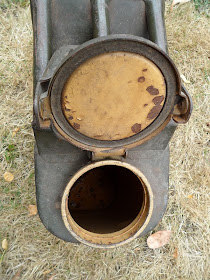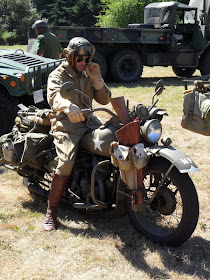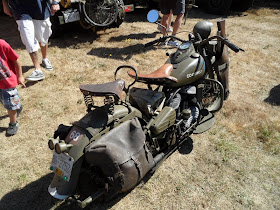Pages
▼
Wednesday, September 28, 2011
Patrol Cap, US Army Digital Desert Camo
Today's posting is a quick one.......... Sweet Pea and I stopped by the local Goodwill store here in Port Townsend this last week and picked up a Patrol Cap in the US digital desert camo pattern. It fits Sweet Pea perfectly, too small for me.............. And the price, 99 cents!
We'll have a few name tapes made up with "SWEET PEA" embroidered on them so she can set up her camo outfits in style. The back of this digi-camo cap has a Velcro strip to attach a name tape....... perfect.
Here are a few shots of the Patrol Cap:
Friday, September 23, 2011
40th Armored Division Patch, 1954 - 1967, California National Guard
Today's posting is a US California National Guard shoulder patch with an interesting history. This patch is from the 40th Armored Division that was active from 1954 to 1967.
The 40th Armored Division was born out of a reorganization of the 40th Infantry Division, right after the Korean War. After the war, the division was outfitted with tanks and settled into peacetime drill routines.......... that is until the outbreak of the Watts Riots in Los Angeles in 1965. The 40th Armored Division was sent into the streets of Watts to keep the peace. Soldiers of the 40th were thrust into the violent and racially turbulent city with "bayonets fixed" and given the task of protecting the lives and property of their fellow citizens. This was a very sad chapter in our country's history and a pivotal moment in the growing racial equality movement in the US. The 40th was reorganized again in 1968, and was broken up into two separate components, armored and infantry.
Here is a link to the 1956 "order of battle" list of all of the units that were assigned to the 40th Armored Division: 40th Armor order of battle 1956
Here is an excellent page that gives the history of the Watts Riots for those of you who wish to learn more about this event:
Watts Riots
For more history on the 40th Armored Division of the California National Guard, check out these links:
Wikipedia 40th_Armored_Division
History of the 40th
To finish things off, here are some historic, archive photos, of the 40th Armored Division in action during the Watts Riots:
The 40th Armored Division was born out of a reorganization of the 40th Infantry Division, right after the Korean War. After the war, the division was outfitted with tanks and settled into peacetime drill routines.......... that is until the outbreak of the Watts Riots in Los Angeles in 1965. The 40th Armored Division was sent into the streets of Watts to keep the peace. Soldiers of the 40th were thrust into the violent and racially turbulent city with "bayonets fixed" and given the task of protecting the lives and property of their fellow citizens. This was a very sad chapter in our country's history and a pivotal moment in the growing racial equality movement in the US. The 40th was reorganized again in 1968, and was broken up into two separate components, armored and infantry.
Here is a link to the 1956 "order of battle" list of all of the units that were assigned to the 40th Armored Division: 40th Armor order of battle 1956
Here is an excellent page that gives the history of the Watts Riots for those of you who wish to learn more about this event:
Watts Riots
For more history on the 40th Armored Division of the California National Guard, check out these links:
Wikipedia 40th_Armored_Division
History of the 40th
To finish things off, here are some historic, archive photos, of the 40th Armored Division in action during the Watts Riots:
Thursday, September 22, 2011
World War 1 Service Medal, United States & Canada
Today I've dug into my box of old WW1 memorabilia and pulled out a pair of World War 1, Victory Medals. I have two of these. One is from the United States and the other is from a soldier that served in the Canadian Forces.
At first glance these two medals are identical, but on closer inspection you can see that there are a number of differences. The two medals are both based roughly on the same design, but with two quite unique and different interpretations. Here are a couple of photos of the medals, side by side. The US medal is the one with the pin clasp and "France" bar. I couldn't get a clear picture of the edge of the UK medal, but it is engraved with the service number and name of the Canadian soldier that it was issued to.
The US version of this medal was instituted in April of 1919 and it was mailed out to US Veterans in April of 1921. It was never awarded to the soldiers in person. On the US medal I have, the "France" bar denotes non combat service in France between April 6, 1917 and November 11, 1918. There are numerous bars that were authorized to be worn on the medal to denote all kinds and types of service and battles. For a complete list of these bar clasps and a good history of the US version of this medal, check out this excellent Wikipedia link: World War One Victory Medal - USA
The United Kingdom version of this medal was awarded to soldiers who served in any theater of the war, between August 4, 1914 and November 11, 1918. Women qualified for this medal for service in the Axillary Forces. For a complete description of this UK version of the medal and information, check out this Wikipedia link: World War One Victory Medal - UK
Sunday, September 18, 2011
Us Army Water Can, G. P. & F. CO. 1951 - Korean War Vintage
While Sweet Pea and I were out and about yesterday, we swung by her gallery to check up on the displays......... and as chance would have it, there was a small flea market set up in the vacant lot along the water on Water Street! While Sweet Pea took care of gallery business, I checked out the "Junk". In the middle of all the odds and ends, I spotted a US Army water can! I think this is the first old water can that I've ever run across! Usually the only ones we see are the standard gas cans. I made a LOW offer and walked off with a vintage, olive drab, 1951, Korean War vintage can! I'll clean this up and get it mounted next to our fuel can on the little 1972 Shasta travel trailer for our desert trips.
These metal water cans were produced from the beginning of WW2 until some time in the 1970's, when the US military started using plastic cans. The water cans are based on the standard 5 gallon fuel can of the times but have a wide, clamp-close lid system and are coated inside to prevent rust.
The water cans are normally marked on the top of the can, under the handle, with the maker and date. The letter "W" indicates that this is a water can. The fuel cans are normally marked on the bottom. Mine is marked with the company name of G. P. & F. CO., with the numbers "51", indicating the the date of 1951. This makes this can a rare Korean War vintage water can! It is rare these days to find any fuel or water can that was actually issued to the US troops that still sport their olive drab paint. A real score! For a great article that really explains all of the details about these old water cans. follow this link over to olive-drab.com
I'll need to do some cleaning of the can and take care of a little surface rust, but all in all, the can is very solid and in great shape! Not bad for 60 year old can!
Here are a few more shots of the can:
Friday, September 9, 2011
Roadmaster Head badge, Cleveland Welding Company 1936 - 1941
While Sweet Pea was teaching her fiddle students at the house yesterday, I headed out to run some errands........ and what would a day of errands be without a quick stop at the local treasure store, "Waste Not Want Not"? Well I'm glad I stopped by. I picked up a great bicycle head badge off of a pre-war Roadmaster Bicycle for 50 cents!
The Cleveland Welding Company manufactured and owned the Roadmaster brand of bicycles from about 1936 until the company was sold to AMF in 1951. This particular head badge came off of one of the pre-WW2 balloon tire bicycles, which would date this badge in the 1936 to 1941 time frame. Roadmaster bicycles were discontinued during the war years. These pre-war bicycles were from the "golden age" of the company, back when Roadmaster was associated with quality.
AMF purchased the Roadmaster brand in 1951 and the quality immediately dropped. In the 1990's all production was moved to Taiwan and the quality sank to its lowest level ever. The Roadmaster brand is now known as a junk, big-box, cheap bicycle, but that wasn't always the case. AMF also owned the Harley Davidson Motorcycle Company from 1960 to 1981......... not the best years for Harley Davidson.
Here's a few photos of the head badge:
And here are a few pages out of the 1939 Roadmaster Catalog:
Wednesday, September 7, 2011
Civil Air Transport Cigarette Lighter, CAT, 1950's to 1970's era
While going through my odds and ends, I ran across a lighter that I picked up quite a number of years ago. This is a VERY unique piece of US history. It is a cigarette lighter from the Civil Air Transport. This was the airline that the US Central Intelligence Agency purchased back in the 1950 and used for covert operations and "black-ops" throughout China and Southeast Asia until it was officially disbanded in 1976. CAT flew regularly scheduled passenger flights as a cover for the covert operations that were being flown at the same time.
Here is a bit of history on the Civil Air Transport: Civil Air Transport
There is actually a non-profit organization dedicated to the history of CAT and a museum and archive located at Texas Tech University: www.air-america.org
Here are the photos of my little piece of US Aviation, covert-ops style:
Tuesday, September 6, 2011
Bundesdrenzschutz Bicycle at Fort Worden Military Vehicle Show
Yesterday Sweet Pea, the pugs and I, all made the trek out to Fort Worden to visit the Labor Day Weekend Historic Military Vehicle Show. We packed a picnic lunch, loaded up the BGS bicycle, and made the hike up to the top Artillery Hill. It was a small encampment with most of the vehicles from British Columbia and a few from Washington State. We had expected a larger gathering with a couple of reenactment camps from WW1 and the Spanish American War, but the camps were nowhere to be found........ We had a great picnic lunch courtesy of Sweet Pea and we enjoyed looking at the vehicles. I got some great shots of the Bundesgrenzschutz bicycle in front of a HUGE M-818 Truck and in front of a WW2 Chevrolet Communications Van.
This M-818 was a BEAST! These things are HUGE! This one was set up as a camper rig for running up in Alaska........... Very cool! It even had a little window set up for their little dog to look out.
There was a good mix of vehicles.......... a couple of ambulances, three motorcycles, several deuce-and-a-halves, a couple of Jeeps, a Humvee............... the motorcycles, Humvee and a Jeep were leaving on a "road trip" to Fort Flagler when we arrived, but I did get a few quick pictures before they took off.
The WW2 Chevrolet Communication Van was great! It was set up as a Canadian Army rig with trailer and it had all of the original radio gear inside. They had a BSA folding paratroop bicycle on the front (not an accurate BSA bike, but still pretty cool). I couldn't resist snapping a few pictures of the BGS bike next to the BSA folder that was strapped on the front of the Chevy......
Here are a few shots of the BSA folding bike on the front of the Chevy....... original frame, but the bars and stem, etc. were newer.....
Here are a mix of shots from around the show:













































































